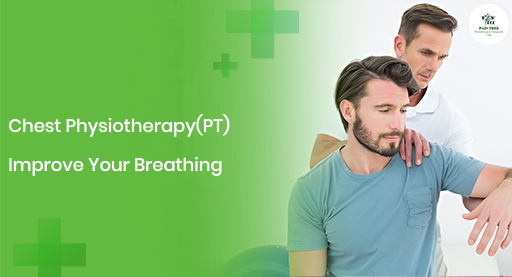Chest Physiotherapy(PT): Improve Your Breathing
Chest physiotherapy is a crucial treatment approach for individuals suffering from respiratory conditions that affect lung function. This therapy involves a combination of techniques designed to clear mucus, improve breathing efficiency, and enhance overall lung health. If you are searching for Chest Physiotherapy in Delhi, this guide will help you understand the procedure, its benefits, and the conditions it treats.
What is Chest Physiotherapy?
Chest Physiotherapy (CPT) is a set of techniques used to assist patients in clearing secretions from their lungs and improving respiratory function. It is commonly recommended for individuals with chronic respiratory diseases, post-operative patients, and those suffering from lung infections.
The therapy involves physical maneuvers and breathing exercises that help clear mucus, expand the lungs, and prevent respiratory complications. It is especially useful for patients with limited ability to clear their airways on their own.
Chest Physiotherapy Procedure: How Does It Work?
The Chest Physiotherapy procedure consists of several techniques that work together to enhance lung function and facilitate mucus clearance. Some of the key techniques include:
- Postural Drainage – This involves positioning the patient in specific ways to allow gravity to help drain mucus from different parts of the lungs. Depending on the area affected, the patient may need to lie down, sit, or be in an inclined position.
- Percussion (Clapping) – A physiotherapist uses cupped hands to rhythmically clap the chest wall, helping loosen mucus in the lungs. This is done in a specific sequence to target different lung areas.
- Vibration Therapy – Gentle vibrations are applied to the chest during exhalation to assist in mucus movement. This can be done manually or with a mechanical device.
- Deep Breathing Exercises – Controlled breathing techniques help expand the lungs and enhance oxygen exchange. Diaphragmatic and pursed-lip breathing exercises are commonly used.
- Coughing Techniques – Patients are trained in controlled coughing to effectively expel loosened mucus. This prevents mucus buildup and reduces the risk of infections.
- Airway Clearance Devices – Devices like oscillatory positive expiratory pressure (PEP) can be used to facilitate mucus clearance. These devices create vibrations that help move mucus upward, making it easier to expel.
- Incentive Spirometry – A tool that encourages deep breathing and helps prevent lung collapse post-surgery or during prolonged illness.
Who Needs Chest Physiotherapy?
Chest Physical Therapy is beneficial for individuals with conditions that cause excessive mucus buildup or breathing difficulties. It is commonly used for:
- Chronic Obstructive Pulmonary Disease (COPD) – Helps in managing symptoms and preventing mucus buildup.
- Cystic Fibrosis – Essential for clearing thick mucus and improving lung function.
- Pneumonia – Aids in clearing lung congestion and speeding up recovery.
- Bronchiectasis – Helps in clearing infected mucus from the airways.
- Asthma – Assists in better breathing control and reducing congestion.
- Post-Surgical Patients – Prevents lung infections and improves breathing after surgery.
- Neuromuscular Disorders – Conditions like muscular dystrophy or ALS, where coughing strength is weak, benefit from CPT.
- COVID-19 Recovery – Many patients recovering from COVID-19 have residual lung congestion, which can be addressed with Respiratory Physiotherapy.
Benefits of Chest Physiotherapy
- Clears Mucus Accumulation – Helps prevent lung infections by clearing excess mucus.
- Improves Oxygen Intake – Enhances lung function, allowing for better oxygen exchange.
- Prevents Respiratory Infections – Reduces the risk of pneumonia and other infections.
- Enhances Breathing Efficiency – Beneficial for individuals with chronic respiratory diseases.
- Speeds Up Recovery – Helps patients recover faster after surgery or illness.
- Reduces Breathlessness – Improves air circulation and reduces difficulty in breathing.
- Minimizes Hospitalizations – Effective lung care can prevent severe complications that require hospitalization.
Is Chest Physiotherapy Painful?
Many patients worry about discomfort during Respiratory Physiotherapy, but the procedure is generally well tolerated. Some individuals may feel slight discomfort, especially during percussion or postural drainage, but it should not be painful. A skilled physiotherapist ensures the treatment is adjusted to the patient’s comfort level.
Can Chest Physiotherapy Be Done at Home?
While some techniques can be performed at home under guidance, it is best to seek professional Chest Physiotherapy in Delhi for effective results. A trained physiotherapist ensures that the techniques are correctly applied, maximizing the benefits and minimizing risks.
Some home-based chest physiotherapy techniques include:
- Breathing Exercises – Practicing deep breathing techniques daily can enhance lung capacity.
- Steam Therapy – Inhaling steam can loosen mucus, making it easier to expel.
- Airway Clearance Devices – Using simple devices like PEP therapy tools at home can help.
- Exercise and Physical Activity – Mild exercise, such as walking or stretching, improves lung function.
However, in severe cases or chronic conditions, professional supervision is essential to ensure proper technique and safety.
Chest Physiotherapy in Delhi: Where to Get Treatment?
If you or a loved one requires Chest Physiotherapy in Delhi, visiting a professional physiotherapy center is essential. At Painfree Physiotherapy, we provide expert Respiratory Physiotherapy tailored to your specific needs. Our experienced physiotherapists use advanced techniques to help you breathe better and recover faster.
Why Choose Painfree Physiotherapy for Chest Physiotherapy?
- Experienced Specialists – Our physiotherapists have extensive experience in treating respiratory conditions.
- Personalized Treatment Plans – We design therapy plans based on individual needs and medical history.
- Advanced Techniques – We use the latest physiotherapy methods for effective lung care.
- Convenient Location in Delhi – Easily accessible for those searching for Chest Physiotherapy in Delhi.
Final Thoughts
Chest Physiotherapy is a highly effective treatment for various respiratory conditions, helping patients improve their lung function and overall health. Whether you need assistance in managing a chronic lung condition or recovering from surgery, seeking professional Chest Physical Therapy can make a significant difference in your well-being.
Looking for expert Chest Physiotherapy in Delhi? Contact Painfree Physiotherapy today to book your session and breathe easier!











